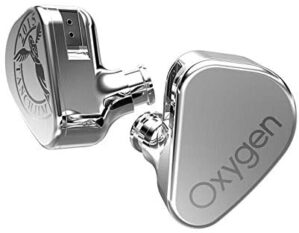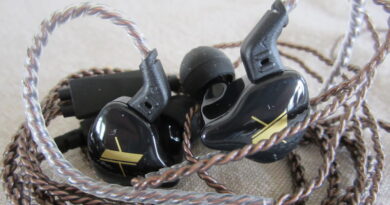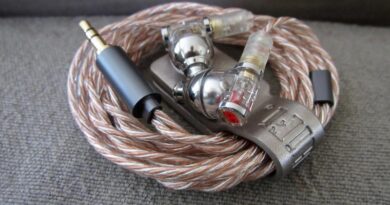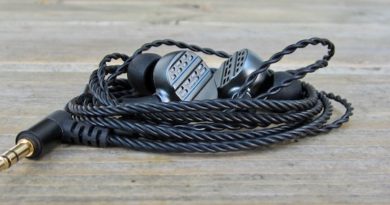Tanchjim Oxygen Review – Just Like A Glove
Took me a while after first auditioning them, but after some time I came accross a good deal and I acquired my own pair of Tanchjim Oxygen. And nothing… their sound fits my preferences just like a glove.
In this Article
At-a-glance Card
| PROs | CONs |
| Clean acoustic timbre and very appealing neutral-bright tonality. | Acoustic-sided presentation, not the best choice for hard rock, EDM and other electronic genres. |
| Beyond spectacular imaging and separation. | Short nozzles may induce fit issues. |
| Perfectly rendered fast bass and sub-bass. | Subpar-quality bundled cables, upgrade |
| Great female vocals. | Beware when upgrading cables: polarity is inverted! |
| One of the best single-DDs I ever auditioned. | Quite unforgiving to low quality or too high voltage swing amps |
Full Device Card
Test setup
Sources: Apogee Groove / Questyle QP1R / Sony NW-A55 mrWalkman – Radius DeepMount or Tanchjim T-APB wide bore tips – Nicehck 16core High Purity Copper cable – lossless 16-24/44.1-192 FLAC tracks.
Signature analysis
| Tonality | Tanchjim Oxygen have a clean acoustic timbre. Tonality is slightly bright, on a fundamentally neutral basis. The modest brightness is not enough to generate a cold sensation. |
| Sub-Bass | Extended all the way down, sub-bass is not elevated in quantity but very present, bodied, almost tactile in its delivery. |
| Mid Bass | Just a whiff more elevated than sub-bass, so still modest in absolute quantity, Tanchjim Oxygen’s mid bass is fast, seriously punchy and detailed. It’s just about perfect for acoustic genres, while will be felt as lacking for EDM, hard rock and such. |
| Mids | Clean and natural especially on the central part. Low and very high mids may do with more body instead. High mids may occasionally deliver a metallic accent on some tracks. |
| Male Vocals | Clean and just good but not the best part of the signature. They are on the lean side. |
| Female Vocals | Very different from males, female vocals are just wonderful, bodied, sometimes even flutey. |
| Highs | Tanchjim Oxygen’s trebles are also very good: airy and sparkly, they are also quite bodied, and never zinging. Cymbals deliver very natural materiality, the never sound artificially thin. No sibilance nor screeching, unless paired with an inappropriate amp. |
Technicalities
| Soundstage | Well extended both in width and depth – of course when the DAC upstream is able to deliver a properly sized image. Definitely top class for a single-DD IEM. |
| Imaging | Beyond spectacular. Instruments are cast on the stage in a totally natural way, each with its own space and definition. |
| Details | Both bass and treble details are high in quantity and quality. Highmid and treble details in particular are never excessively thin, nor fatiguing. |
| Instrument separation | Another very well rendered aspect: the different instruments in the band are properly distinct even during crowded phrases, layering is really well executed |
| Driveability | Tanchjim Oxygen are not very sensitive (don’t be fooled by the “110dB” figure you read on the specs – those are per Vrms, equivalent to apprx 95dB/mW) so an amp is recommended, and actually one capable of careful power calibration is high recommended to avoid presence trebles to go shouty sometimes. A Sony NW-A55 is the minimum recommended quality source to fully exploit Oxygen’s mastery. |
Physicals
| Build | Stainless steel housings with a very stylish engraving. Available in 2 versions – silver or black – I do prefer the latter but they both look very nice |
| Fit | Tanchjim Oxygen housings have a greatly calibrated size and shape (for my ears at least), too bad for the short nozzles which may be annoying. After quite some rolling Radius DeepMount tips are best in terms of grip but compromise a bit in terms of isolation and presentation (a bit more bass, and a somewhat more intimate stage). Tanchjim’s own T-APB wide bore tips (available separately) are oppositely best for presentation accuracy and isolation but force me (ymmv) to push the housing a bit too much into the concha, with some compromise on comfort. Stock tips – both small and wide bore ones – are frankly inadequate being too short. |
| Comfort | Given the short nozzle issue, much depends on lucky eartips matching. See “fit”. |
| Isolation | Housings + DeepMount fittings don’t completely fill my conchas, so passive isolation is barely OK-ish in that case. Gets better with shorter nozzles, if they are otherwise “acceptable” comfortwise |
| Cable | While it’s at first nice to find 2 different bundled cables in the package, the disappointment is even bigger after checking that both are low quality ones. Nicehck 16core High Purity Copper is a good option here. One very important note: Oxygen’s 2pin connectors have swapped polarity compared to the vast majority of 2pin drivers I came accross. It’s important to respect polarity to avoid some phasing issues which are mainly coming accross in terms of bad / incoherent imaging and spatial reconstruction. Female connectors on the housings are not heavily recessed so that’s not an obstacle to flipping most third party 2pin cables you may want to adopt, but do keep in mind that you will need to remove shaped earhooks if present of course. |
Specifications (declared)
| Housing | Stainless steel housings with a mirrored high-gloss pattern, a frame, a cavity and a sand grain panel. Nano-scale silver ion vacuum plating technology applied on the cavity can resist 99% of bacteria. |
| Driver(s) | 10mm Carbon Nanotube Diaphram Dynamic Driver |
| Connector | 2pin 0.78mm |
| Cable | 1.2m OFC Silver Plated Cable Without Mic & 1.2m OFC Cable With Mic |
| Sensitivity | 110 dB/Vrms equivalent to approx 95dB/mW |
| Impedance | 32 Ω |
| Frequency Range | 10–40.000 Hz |
| Package & Accessories | Carry case, 1 set of S/M/L wide bore silicon tips, 1 set of S/M/L narrow bore silicon tips, Tanchjim badge, spare cloth meshes |
| MSRP at this post time | $269,99 |
Other notes and conclusions
Those who follow my articles know my musical preferences are quite sided – I’m not at all a generalist, I actually very much prefer listening to cool jazz for most of my time, with some secondary interest into classical, and some prog rock.
That’s why I cast a special eye on drivers tuned to sound particularly well for those genres, which are not at all easy to render, as they require control, calibration and fidelity – not really so easy to find features.
Tanchjim Oxygen get my top appreciation as drivers for cool jazz, bebop, avantgarde and even for vocal jazz – female voices especially, due to their particular proficiency on those.
I can probably name just one other IEM under their price offering a similarly neutral and non excessively bright timbre paired with sound quality refinement which is at least in the league of Tanchjim Oxygen, and that’s final A3000. Other less neutral i.e. more “accented” tuning alternatives I use for the same musical genres are the cheaper (and less refined) Shouer Tape, or the similar-priced and equally sophisticated Ikko OH10. End of my jazz-specialised sub-€300 list, really.
While not the most capricious IEM I ever tried, Tanchjim Oxygen do significantly benefit from an at least decent quality amping source. Apart for that, as for the vast majority of IEMs best to stay away from high-voltage amps e.g. desktop ones, or those multi-W-powered daps, or if you really must use one of those at least plug an iFi iEMatch at in the middle (do it!).
As I mentioned above, Oxygens oddly feature opposite cable polarity compared to what most other 2pin-connector drivers usually adopt. I personally checked both stock cables with a multimeter and they do have that. I also asked Tanchjim tech support for verification and they acknowledged the situation. Remember to take care of that when plugging a third party cable, which due to the low quality of both bundled cables is more than a rec to be honest. Swapping polarity won’t harm your drivers, but will produce some fancy imaging oddities on some tracks.
Disclaimers
The Tanchjim Oxygen pair I am discussing have been personally purchased, not offered as a review loaner. You can find them on mutiple online outlets like here, and here.
This article also appears on my personal audio blog, here.










